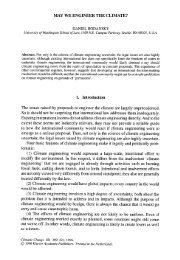ThorEA - Towards an Alternative Nuclear Future.pdf
ThorEA - Towards an Alternative Nuclear Future.pdf
ThorEA - Towards an Alternative Nuclear Future.pdf
Create successful ePaper yourself
Turn your PDF publications into a flip-book with our unique Google optimized e-Paper software.
Case Study 2: Letter of support from Siemens AG<br />
Nonbinding Letter of Support for the Development of Accelerator Technology for the use in Healthcare<br />
<strong>an</strong>d <strong>Nuclear</strong> Industries<br />
Siemens AG is a global powerhouse in electrical engineering <strong>an</strong>d electronics. The comp<strong>an</strong>y has over 400,000 employees<br />
working to develop <strong>an</strong>d m<strong>an</strong>ufacture products, design <strong>an</strong>d install complex systems <strong>an</strong>d tailor a wide r<strong>an</strong>ge of services<br />
to individual requirements. Siemens is <strong>an</strong> integrated technology comp<strong>an</strong>y with a clear focus in the sectors Industry,<br />
Energy <strong>an</strong>d Healthcare. Each of these sectors supplies a wide r<strong>an</strong>ge of product solutions including the design <strong>an</strong>d<br />
m<strong>an</strong>ufacture of m<strong>an</strong>y particle therapy centres <strong>an</strong>d energy generation systems.<br />
Siemens is interested in the development <strong>an</strong>d exploitation of accelerator technologies for next generation particle<br />
therapy, nuclear processing <strong>an</strong>d energy systems. Looking to the future, in order for accelerators to be more widely<br />
available it is import<strong>an</strong>t to make them compact, reliable <strong>an</strong>d fin<strong>an</strong>cially competitive. Therefore, Siemens has<br />
considerable interest in the proposed <strong>ThorEA</strong> project which will focus on developing the underpinning technology to<br />
realise accelerator driven subcritical reactor systems, given that the technology c<strong>an</strong>not be brought to full commercial<br />
application without signific<strong>an</strong>t adv<strong>an</strong>ces in technical development <strong>an</strong>d physical demonstration projects. Specifically,<br />
Siemens’ interest focuses upon the business case, accelerator development, reliability etc. Should the project move<br />
forward we c<strong>an</strong> envisage potential collaboration <strong>an</strong>d engagement in the following areas: business case, linear<br />
accelerator technology, high power pulsed equipment <strong>an</strong>d productionisation.<br />
Therefore, Siemens believes that the combination of its expertise with <strong>ThorEA</strong>, could lead to successful development<br />
of this technology for the benefit of all parties.<br />
Signed:<br />
On behalf of Siemens AG:<br />
Dr Oliver Heid,<br />
Head of Healthcare Technology & Concepts<br />
3.10 IAEA endorsement of the proposed<br />
ADSR programme<br />
The following message of support for the proposed R&D<br />
programme was received from Alex<strong>an</strong>der St<strong>an</strong>culescu, of<br />
the <strong>Nuclear</strong> Power Technology Development Section of the<br />
International Atomic Energy Agency (IAEA), Vienna:<br />
“During the pioneering years of nuclear energy, from the<br />
mid 1950s to mid 1970s, there was considerable interest<br />
worldwide to develop thorium fuels <strong>an</strong>d fuel cycles, given the<br />
m<strong>an</strong>y potential benefits. Indeed, those studies have identified<br />
m<strong>an</strong>y incentives for the use of thorium fuel. Thorium resources<br />
are larger th<strong>an</strong> those of ur<strong>an</strong>ium, <strong>an</strong>d neutron yields of 233U in<br />
the thermal <strong>an</strong>d epithermal regions are higher th<strong>an</strong> for 239Pu<br />
in the ur<strong>an</strong>ium-plutonium fuel cycle. The introduction of the<br />
Thorium-based nuclear fuel cycle would therefore vastly enlarge<br />
the fissile resources by breeding 233U. Large thorium deposits in<br />
some countries, coupled with a lack of ur<strong>an</strong>ium deposits in those<br />
countries is <strong>an</strong>other strong incentive for the introduction<br />
of thorium based nuclear fuel cycles.<br />
Other reasons identified in past studies are the potential for<br />
fuel cycle cost reduction, the reduction in 235U enrichment<br />
requirements, safer reactor operation because of lower core<br />
excess reactivity requirements, <strong>an</strong>d safer <strong>an</strong>d more reliable<br />
operation of ThO2 fuel as compared to UO2 fuel at high burnup<br />
due to the former’s higher irradiation <strong>an</strong>d corrosion resist<strong>an</strong>ce.<br />
The TMI <strong>an</strong>d Chernobyl accidents, <strong>an</strong>d growing long-lived<br />
radioactive waste issues provided new incentives for the use of<br />
Thorium-based fuel cycles, given their potential for reducing the<br />
production of plutonium <strong>an</strong>d higher actinides, as well as the<br />
possibility for a more effective incineration of plutonium <strong>an</strong>d<br />
long-lived radiotoxic isotopes.<br />
On the other h<strong>an</strong>d, the thorium fuel cycle has some<br />
disadv<strong>an</strong>tages when compared with the ur<strong>an</strong>ium fuel cycle,<br />
which were also recognized from the very beginning of thoriumfuel<br />
related activities, more specifically: the thorium-233U fuel<br />
cycle is characterized by a much stronger gamma radiation level<br />
th<strong>an</strong> the ur<strong>an</strong>ium-plutonium cycle, <strong>an</strong>d therefore h<strong>an</strong>dling<br />
during fabrication requires more care; nuclear reactions by<br />
neutron absorption <strong>an</strong>d decay schemes for Thorium-based fuels<br />
are more complicated; longer water storage time for the spent<br />
fuel is needed due to higher residual heat; potential difficulties<br />
in down stream spent fuel reprocessing.<br />
Against this background, the IAEA is supporting interested<br />
Member States activities in Thorium-based reactor <strong>an</strong>d fuel<br />
cycle technologies. In particular, accelerator technologies<br />
to enable the exploitation of such fuels <strong>an</strong>d fuel cycles in<br />
accelerator driven subcritical reactors are of particular<br />
relev<strong>an</strong>ce in this context.<br />
IAEA warmly welcomes the proposed accelerator driver<br />
development programme embodied in the <strong>ThorEA</strong> project<br />
as a positive contribution to the international effort to<br />
secure the eventual global deployment of sustainable<br />
thorium-fuelled ADSR power generation systems.”<br />
A report prepared by: the thorium energy amplifier association 31



